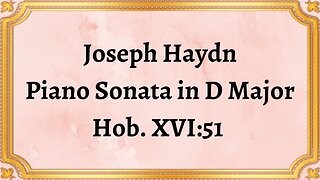Premium Only Content

George Frideric Handel Trio Sonata in E flat major
#classicalmusic #Handel #TrioSonata #Eflatmajor #musiccomposition #concert #sonata
JEAN-PIERRE RAMPAL, flute
PIERRE PIERLOT, Oboe
ROBERT GENDRE, Violin
PAUL HONGNE, Bassoon
ROBERT VEYRON-LACROIX, Harpsichord
The Trio Sonata in E flat major composed by George Frideric Handel is a stunning example of his genius in the genre of Baroque music. This essay will delve into the historical context, structure, and notable features of this extraordinary musical composition.
Handel, a German-born composer, was a prominent figure in the Baroque era, known for his prolific output of operas, oratorios, and instrumental works. The Trio Sonata in E flat major was composed around 1725 and represents the pinnacle of Handel's chamber music compositions. This piece showcases his mastery of counterpoint and his ability to create expressive melodies within a complex musical framework.
The Trio Sonata in E flat major follows the traditional structure of a trio sonata, which typically features two solo instruments accompanied by a basso continuo. Handel's composition consists of four movements:
1. Allegro: The opening movement is characterized by its lively tempo and vibrant melodic lines. Handel skillfully weaves intricate counterpoint between the two solo instruments, creating a sense of dialogue and musical interplay.
2. Largo: The second movement is a slow and lyrical section that provides a beautiful contrast to the energetic opening. Handel's rich harmonies and expressive melodies evoke a sense of introspection and emotional depth.
3. Allegro: The third movement returns to a spirited tempo, showcasing Handel's mastery of virtuosic writing. The solo instruments engage in dazzling runs and trills, displaying their technical prowess.
4. Allegro: The final movement is a lively and joyful conclusion to the sonata. Handel combines elements of dance-like rhythms and contrapuntal textures, creating a sense of exhilaration and celebration.
One notable feature of Handel's Trio Sonata in E flat major is his use of ornamentation. Throughout the composition, Handel incorporates trills, mordents, and other embellishments, adding depth and expressiveness to the melodic lines. Additionally, the interplay between the two solo instruments creates a sense of conversation and musical dialogue, showcasing Handel's mastery of counterpoint.
Conclusion:
George Frideric Handel's Trio Sonata in E flat major stands as a testament to his brilliance as a composer. Through its masterful composition, intricate harmonies, and expressive melodies, this piece exemplifies the beauty and complexity of Baroque music. Whether performed in a concert hall or listened to in the comfort of one's home, Handel's Trio Sonata continues to captivate audiences with its timeless charm and musical virtuosity.
You have the opportunity to support the channel:
https://destream.net/live/RadSiarAl/donate
https://www.buymeacoffee.com/6355radsiaral
-
 6:07
6:07
Classical music_Music Inspiration
1 day agoJoseph Haydn Piano Sonata in D Major, Hob. XVI:51
191 -
 18:53
18:53
DeVory Darkins
1 day ago $3.94 earnedTrump JUST ENDED Mayor Karen Bass During HEATED Meeting
8.41K50 -
 21:06
21:06
Russell Brand
3 hours agoIT'S COMING
39.3K187 -
 21:26
21:26
Stephen Gardner
23 hours ago🔥What JUST leaked out of Congress must be STOPPED NOW!
71.9K161 -
 53:25
53:25
tether
11 days agoStability and Freedom in Chaos: The Story of Tether USD₮ | Tether Documentary (USDT)
100K5 -
 56:44
56:44
VSiNLive
2 days agoFollow the Money with Mitch Moss & Pauly Howard | Hour 1
46.8K2 -
 36:50
36:50
Anthony Pompliano
2 days ago $10.20 earnedInvestors Are ALL-IN On Bitcoin
28.9K7 -
 32:19
32:19
SB Mowing
9 days agoA Backyard She’s NEVER Seen – Now Safe for the Kids to Play!
35K17 -
![[Day 26] CS Blast bounty baby](https://1a-1791.com/video/fwe2/8a/s8/1/Z/H/j/_/ZHj_w.0kob-small-Day-26-CS-Blast-bounty-baby.jpg) 2:09:11
2:09:11
ggezlol_tv
7 hours ago[Day 26] CS Blast bounty baby
72.7K2 -
 2:32:17
2:32:17
Sgtfinesse
7 hours ago💥Sunday Morning Hunt for Featherweight Artifact | New World PVP Server: Sclavia
78.2K4